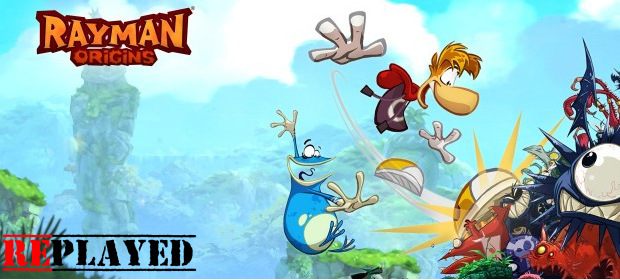I’ve never been a big fan of platform games. There was a time, back when consoles were in their infancy, when Super Mario Bros., Mega Man and New Zealand Story were all I played, because they were all I had. Once I discovered other genres, I abandoned platform games in favour of pretty much anything else, only returning for brief relationships with classics like Ducktales, Super Ghouls ‘N’ Ghosts and Sonic the Hedgehog. Because of this, I’m almost ashamed to say, I never played 1995’s Rayman. I never played any of its sequels or spin-offs – not even Raving Rabbids. Until I owned a PlayStation Vita, I lived in a Rayman-less universe, devoid of armless dream warriors, only aware of his existence in so far as I knew what the games were all about, knew what the protagonist looked like, knew it was popular.
So why did I choose to buy Rayman Origins as the second game (alongside Uncharted: Golden Abyss) on my Vita? Partly because it was one of about seven games available at the time but, mostly, it was because I really, really liked the box art. I really, really liked the screenshots. I really, really liked the gameplay videos I’d seen and the review scores it was getting and I really, really liked Rayman. So I bought it, took it to the hospital with me and, while my wife (God bless her) was recovering from a C-Section and my new son slept and slept and cried and slept, I fell in love with Rayman. Besides taking photos, texting family members with the weight and going goo-eyed every ten minutes or so, I had very little else to do for 48 hours.
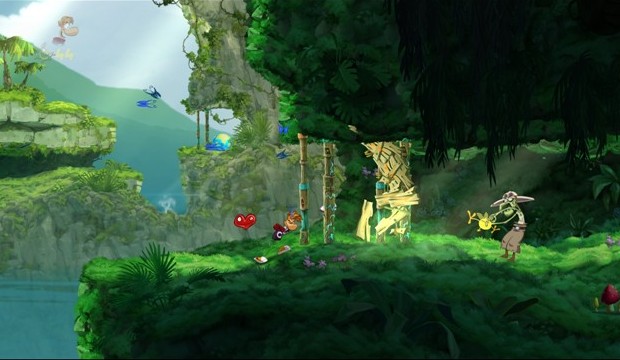
LIFE COULD BE A DREAM: Rayman Origins is a return to form for the armless wonder, back to the side-scrolling roots not seen since the original release. The story is mostly throwaway, depending on how much context you need the action to have, although the gameworld itself is beautiful. It’s all about dreams, see? Which is why it gets away with such disparate, disjointed, unconnected worlds, oddly bound by their dissimilarities.
The series has never been known for its deep, over-arching storylines or clever exposition, instead using a combination of bright colours and bold characters to hide the fact that the actual narrative has very little real context. Suffice to say, in Rayman’s world, the Bubble Dreamer is an almost Buddha-like entity who resides over all things from the Glade of Dreams. When the combined snores of the Bubble Dreamer, Rayman, and his friend Globox disturb an evil being from the Land of the Livid Dead, she invades the world, sending out an army of Darktoons (baddies) to imprison the Electoons (goodies) and usher in an era of darkness.
So Rayman and Globox and a handful of their Teensy companions set off on an epic quest to free the Electoons and Nymphs from their imprisonment and put the world right once again. But who cares? The joys of Rayman are not to be found in the storytelling. Ubisoft could have pasted any old story onto the back of Rayman Origins’ breakneck gameplay and the result would be exactly the same. The joys of Rayman Origins lie in the adventure itself, in the sense of speed and momentum that carries you, grinning, from one end of a level to another.
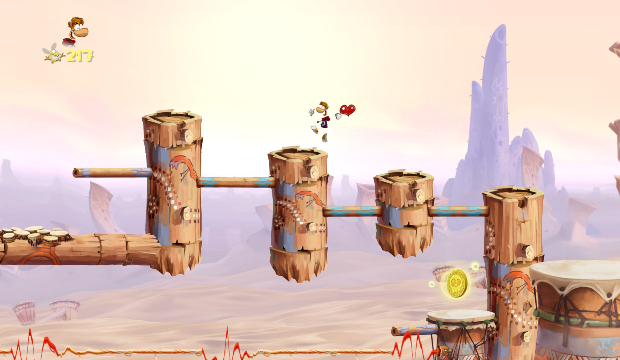
OFF THE WALL: Almost everything about Rayman: Origins is reliably off-kilter, not least the art style. While the limbless one himself is mostly unchanged since his original appearance 18 years ago, the worlds through which he bounds have evolved considerably. The first of these worlds is the Jibberish Jungle, which, being the introductory starter of Origins’ seven hubs, is the closest to sedate that it gets. Compared to later stages, the jungle is an absolute cakewalk, one to be mercilessly re-played until you’ve well and truly made it your own.
The rather sharp incline in difficulty in world number two, the Desert of Didgeridoos, is well-lamented, and a trend that continues throughout. From the Sea of Serendipity to the Mystical Pique, Origins’ relentlessly-increasing difficulty is a deliberate design decision and there’s nothing to stop the player with enough skill and time from acing every single stage. Eventually.
It’s rare you’ll have as much fun jumping and running as you will in Rayman Origins, especially in those early stages as you swing and slide through the jungle. It’s all helped along by a level design that encourages and rewards exploration. Being side-scrolling and 2D, Origins doesn’t feature branching paths and secret passages – but it does feature lots and lots of hidden doors.

NYMPH MANIAC: Stashed away behind foliage and bits of scenery you’ll find entrances to tiny bonus areas, wherein you’ll usually see a cage full of Electoons guarded by an energy field. In order to break the energy field, you need only destroy the enemies in the area – often easier said than done. Origins has a huge line-up of nasties, from wrinkled old crones to bloated demonic chefs – though thankfully, they don’t require particularly clever tactics beyond kicking them really hard.
If you want to rinse a level, you’ll need to collect every Lum (Origins’ all-singing, all-dancing currency) and free every Electoon, and so finding each and every one of these hidden areas is paramount. Things become easier on later re-runs, as every new world brings with it a new ability gifted when you chase down a cage containing an imprisoned Nymph at the end of each world.
First off, Rayman gains the ability to glide – essential for riding thermal up-drafts in certain levels. You’ll also gain the ability to shrink yourself at certain points, and run up curved walls. Not all areas have elements dependant on return runs, but most of the powers Rayman can develop come in handy for shaving seconds off your completion times.
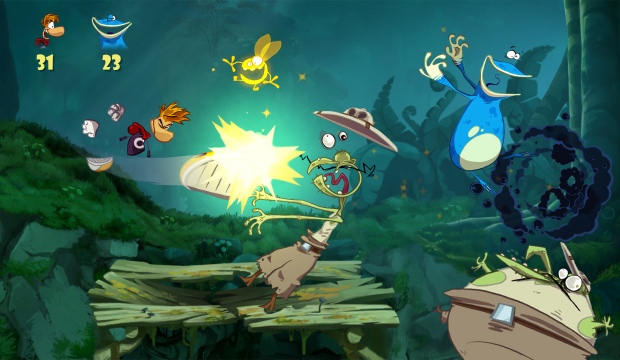
AND THE WORLD SMILES WITH YOU: Which, predictably, is where Rayman Origins shines. This is not a platformer built on forward thinking, or carefully avoiding obstacles to land an insanely difficult jump. This is a platformer about running really fast and surviving every trap and enemy by the skin of your teeth.
This is never more apparent than during the Chest-Chase levels, wherein your job is to hunt down a runaway container and liberate a huge ruby tooth (for reasons that probably make perfect sense in Rayman’s world). The chest gallops off at speed, and the left-hand side of the screen starts moving – if you can’t keep Rayman somewhere between the two, it’s squish-time.
These levels throw obstacles at you thick and fast, and the simplest of mistakes will see you catapulted back to the beginning. Hesitation or indecisiveness are major no-no’s, and only by gritting your teeth and nailing every split-second jump, slide, wall-run and swing can you hope to survive. It can be incredibly frustrating, but the sense of accomplishment when you finally corner your quarry is immense. These moments, like so much of Rayman Origins, were designed to make you smile.
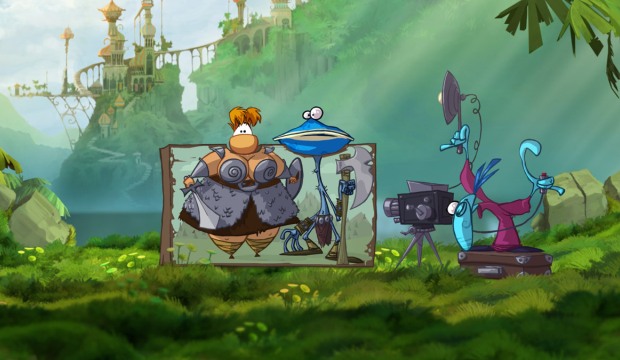
WHAT’S NOT TO LOVE: It’s the unavoidable sense of happiness that Origins evokes that makes me love it so. It’s not about killing the bad guys (although some of the screen-dominating bosses you’ll fight are pretty epic), or bombastic posturing (except Rayman’s end-of-level pose on the beach cut-out of a voluptuous Valkyrie maiden), it’s about having fun.
It’s the kind of game that makes it hard not to grin, even when it’s beating you. No matter how difficult a level may appear, when you swear and curse you do so in a determined, angry-with-yourself kind of way and immediately hit Retry. That’s the appeal that Origins has: you want to beat it, simply because you want to keep playing it. It’s not a challenge in the same vein as platformers like N+ or Super Meat Boy; it’s not deliberately designed to make you hate yourself. The first time you nail a tough level, you will have cracked it, and every subsequent run-through will see you getting faster and faster.
For 100% completion you’ll need to beat the time trial version of every level, which often require near-flawless runs. A handful of levels in each world also allow you to return and race against the a ghost version of yourself or another player. They’re not only fun, but also great practice runs, giving you something to focus on beyond the level itself so that the running, jumping, punching and swinging become almost like second nature.
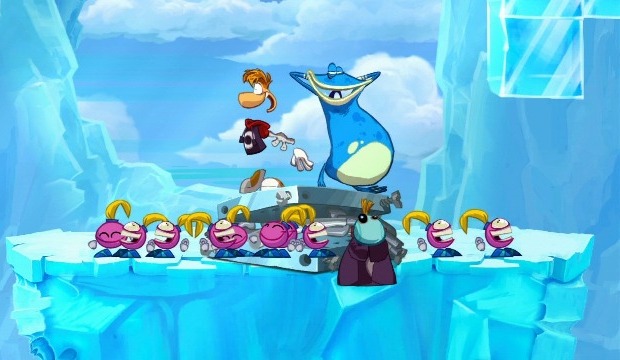
ALL GOOD FUN: Origins allows the option to play alongside four friends locally, but sadly omits the option to play online. It’s probably the most disappointing element – it might be Origins only real disappointment, period. Being able to sit around a TV with your mates is pure joy, as each of your characters bound through the twisting levels, bringing each other back from the brink of a bubbly death and filling the screen with dizzying colour, but you can’t experience the same joy when your mates have gone home.
Conversely, perhaps the greatest triumph of Origins is the soundtrack. It’s a mind-bogglingly eclectic mix of sounds that shouldn’t work but somehow does; from rising, inspiring chords through didgeridoos, electric guitars, keyboards, synthesisers and at least one kazoo, the scoring in Rayman Origins is as lovingly skewed as the artistry. Every piece of music is perfectly tailored to its accompanying stage, particularly the flying levels, wherein Rayman leaps onto the back of an oversized “Moskito” to a pounding score reminiscent of the Dambusters theme.
Everything about Rayman Origins is designed to appeal to the excitable child within all of us. Whether you’re a gamer old enough to remember 1995’s original, or, like me, someone who managed to miss every iteration of the franchise until this one, Origins will make you smile. It’s not about being flash or expensive, it’s about having a good time – and surely that should appeal to everyone.


